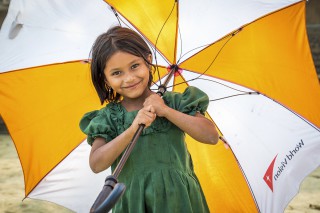Rohingya refugee girl, Jannatul, 5, with one of many World Vision umbrellas handed out to Rohingya children and adults. She is the sole-surviving child of Rohingya widow Hasina.
Janattul’s name means “the best heaven.”
Story Notes:
“Could your country pray that we would have peace in Myanmar?” asks Hasina, 26, whose husband and two of her three children were killed in the violence against the Muslim-minority Rohingya in September 2017. The family became separated when shooting started in their village, and homes were burned down. “Jannatul was with me, but I didn’t know what had happened to my husband and my children,” she says. “Later I saw them dead.” Mohamed, 30, was shot; their son, Hafej, 2, and one-year-old daughter, Kalima, stabbed to death.
Today mother and daughter live in Cox’s Bazar, southern Bangladesh with more than 920,000 other refugees in camps built on soft hilly earth where eucalyptus once grew and elephants roamed. World Vision made sure Hasina and Jannatul, 5, had a sturdy home in the camp, reinforcing their makeshift shelter with cement, tarps, and bamboo to help protect them from monsoon rains.
Jannatul goes to a child-friendly space to play and learn, her regular attendance and sunny smile making her a favorite of the World Vision staff.
Hasina recently started working with a cash-for-work project run by World Vision in partnership with the World Food Program. She fills sandbags for construction crews preparing the camp for the upcoming monsoon rains in May. Rohingya are not allowed to work outside the camp, so the money she earns as a now single mother helps buy to food for Jannatul. World Vision’s cash for work programs include building a drainage system for when the monsoon rains come. They are working to stabilize the land all over the camps. There was a problem at first with women working. But at the time of this writing (January 2019) there were 33,362 female households—16 percent of the 208,512 families in t


